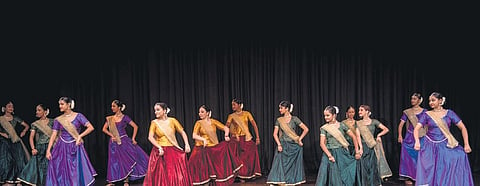

Jayashree Acharya, a well-known classical dancer, has carved a niche for herself in Kathak. A disciple of the legendary Padma Vibhushan Pandit Birju Maharaj, she is a versatile performer and has been highly acclaimed for her dance across the world. Rasik Performing Arts recently celebrated the 26th edition of Prayaas at Gurugram’s Apparel House. Prayaas is the annual show presented by Rasik under the guidance of Acharya. The event showcases budding talents in classical art and acclaimed artists such as Pandit Jayant Kastuar, Shri Ravindra Mishra, Chitra Sharma, and Dibakar Das have performed on its stage. Acharya’s duet ‘Channd Leela’ a rhythmic kathak marvel celebrating musical instruments’ unique qualities, was the highlight of the cultural extravaganza/
Excerpts from the conversation:
Your Kathak classes in Gurugram have spawned a generation of young artists. What is the motive behind Prayaas?
Kathak has been my window into the rich world of dance, rhythm and poetry. Prayaas is my attempt to bring this rich medium of expression and education to young minds drawn to Kathak. We try to make the audience in Gurugram understand the love for classical art. Since 2004, Rasik Performing Arts has been involved in deepening the engagement of audiences and students with Indian classical arts. While numerous workshops have connected young learners with a network of established artists, a series of Baithaks have brought the arts closer to many interested Rasiks.
You received training in Kathak Kendra in Delhi under Guru Reba Vidyarthi and Pt Birju Maharaj. How would you describe the expertise and style of Panditji?
I was introduced to formal training in kathak by Sant Gopal Mishra in Ayodhya and received further training under Guru Reba Vidyarthi and then Pt Birju Maharaj. My association with Maharajji has been a guiding light in my career. I worked under Maharajji for many years, observing his choreographic style and I carry forward his legacy. He was a magician. In the starting days, I was not able to follow his teaching style as he would explain it in metaphors. However, when I myself started teaching, all of it just came back. His way of teaching was very natural. He always used to give examples from nature and say that nature is the biggest teacher.
How did your journey in Kathak begin?
I started dancing at the age of six. I also played sitar, but I was passionate about vocals. But all of it changed when my masterji took me to Maharaji’s class. When I saw the dancers, looking so graceful, it changed my perspective. From that point, I just wanted to learn under Maharaji and I’m blessed that my wish got fulfilled.
Do you think kathak needs exposure so people living abroad can also understand the essence of the art form?
I lived in London for ten years and taught kathak. To be very honest, they really appreciate and respect our culture. When they are serious about learning, they look up for history, do research and try to inculcate our culture.
What are the most important traits a dancer should have? What advice would you give to aspiring dancers?
Dance is a very difficult subject as it also has music, literature and rhythm. So to be able to understand it or become a good dancer, you need to have a good understanding of vocals, tabla, to get a hang of rhythm and literature. A dancer’s training begins with training the body to achieve speed, flow and dexterity in movement, along with a basic understanding of rhythm. The hallmark of an Indian classical dancer lies in her ability to draw her audience into the myriad layers of the narrative, through Abhinaya.